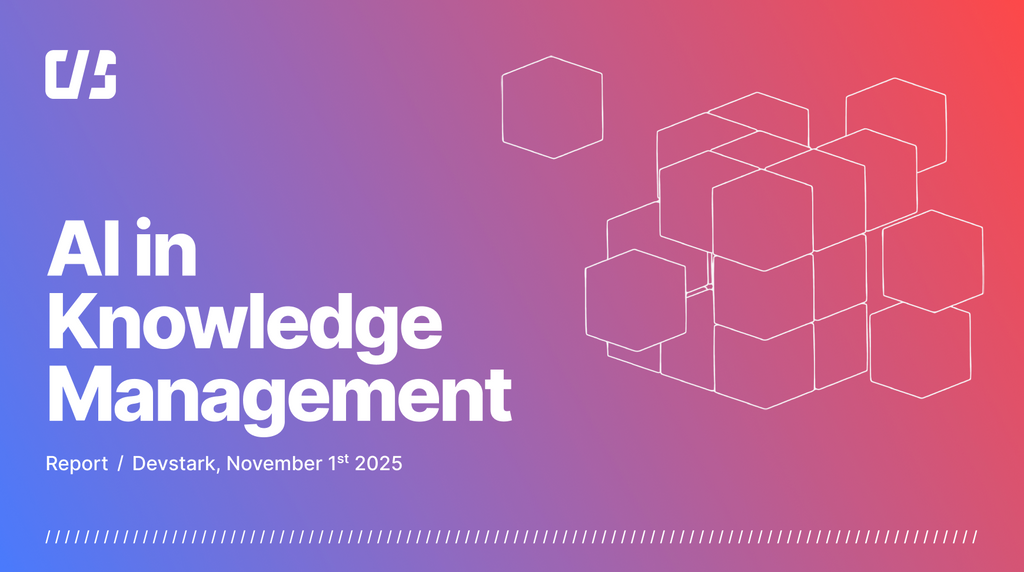The future of AI in corporate knowledge management
For years, large enterprises struggled with finding, organizing, and using corporate knowledge effectively. Today, the narrative has shifted. Fortune 500 organizations are no longer overwhelmed by an ocean of files, emails, manuals, and tribal knowledge. Instead, they are using AI to surface the right insight at the right moment, and transforming how employees learn, solve problems, and make decisions.
AI-driven knowledge management (AI-KM) is becoming the backbone of operational excellence. From real-time troubleshooting on manufacturing lines to intelligent coding assistance, these systems are weaving institutional expertise directly into everyday workflows.
Below, we will explore how companies will be reinventing enterprise knowledge with AI in the near future.
If you'd like to dive deeper into AI-KM with real-world examples and implementation strategies, feel free to download a 54 page report our research team has prepared on artificial intelligence in knowledge management by clicking the button below.
Full AI-KM report (54 pages)
The infrastructure era (2025–2027)
Laying the foundations of intelligent knowledge flow.
The first stage of this transformation focuses on building the invisible architecture that allows knowledge to move freely and meaningfully throughout an enterprise. Companies worldwide are already directing massive investments into foundational technologies that prepare their information environment for AI.
1. Meaning-aware databases
Legacy systems built around keywords and rigid folders are giving way to semantic knowledge architectures. In this era, every document, message, transcript, and report will be converted into machine-understandable meaning. AI will learn how concepts relate to one another, not just which words appear on a page. Information will become interconnected, forming a foundation for advanced reasoning.
2. Secure, interoperable systems
Organizations are building bridges between historically disconnected data sources.
AI connectors safely traverse CRMs, ERPs, emails, document repositories, and analytics systems.
“Traceability by design” ensures every answer AI gives can be audited and verified.
Privacy, compliance, and identity controls are embedded directly into the data pipeline.
This marks the shift from fragmented knowledge silos to unified knowledge ecosystems.
3. The rise of knowledge operations teams
New roles emerge, such as knowledge engineers, AI librarians, and semantic data specialists. These teams will curate and refine data, govern model behavior, and maintain alignment between AI systems and human expertise.
The organization starts treating knowledge as a living asset that requires ongoing care, not just a one-time upload.
By 2027, most mature enterprises will adopt a real-time knowledge infrastructure. Companies will describe this shift not as “installing AI” but as connecting their organizational brain.
The interface revolution (2027–2030)
From searching for knowledge to having knowledge come to you.
Once the infrastructure is stable, attention shifts to how people actually use information. Between 2027 and 2030, knowledge access will become dramatically more intuitive and human-centered.
1. Conversational workflows become the norm
Employees stop navigating folders and start interacting with systems like a teammate.
Asking a question by typing, speaking, drawing, or gesturing
Receiving answers in seconds, written in natural language
Getting follow-up suggestions or clarifications tailored to the task
Tools become conversational companions, not just static software.
2. Multimodal knowledge delivery
AI begins to understand and generate content across every format simultaneously: Documents, images, charts, spreadsheets, diagrams, videos, slide decks, etc. Knowledge adapts to the way each person thinks.
3. Role-aware intelligence
AI systems will know whether you’re a designer, engineer, analyst, or executive and respond accordingly.
For example:
Two employees asking the same question will receive different answers, tailored to their responsibilities.
Workflows will adjust themselves based on department, project context, or past behavior.
Systems will anticipate user needs and surface relevant insights proactively.
These innovations will significantly reduce the time people spend searching, validating, or reformatting information.
By 2030, the line between “using AI” and “collaborating with AI” will blur so much that people won’t even think about it. Tools will simply feel like intelligent colleagues, minus the office gossip.
The age of autonomous knowledge (2030–2035)
Knowledge systems that maintain and grow themselves.
The final wave represents the biggest disruption yet. As organizations cross the 2030 threshold, AI systems become capable of maintaining, improving, and expanding corporate knowledge without human intervention.
These systems will operate like a self-sustaining ecosystem.
1. Self-updating knowledge bases
AI will continuously monitor: IT tickets, internal chats, regulatory updates, technical documentation, industry research, and market intelligence, then automatically update internal knowledge to keep it current.
2. Autonomous error detection and correction
Outdated procedures, broken links, and wrong instructions will all be fixed automatically. Models will cross-check information, flag inconsistencies, and repair them.
3. Automated knowledge creation
AI will generate training materials, manuals, step-by-step guides, risk assessments, executive summaries, compliance updates, etc. All without waiting for a request.
4. Self-governed compliance and policy alignment
Intelligent guardrails will make sure that everything AI creates follows company policies, sensitive data is protected, audit trails are preserved, and updates meet legal and industry standards.
By 2035, experts predict that 95% of enterprises will rely on fully autonomous knowledge systems. Paper files, outdated manuals, and missing documentation will become relics of a bygone era, one that was slower and more prone to error.
Your company’s knowledge system will know what you need, often before you ask.
Conclusion: The decade when knowledge learned to think
Between 2025 and 2035, corporate knowledge will transform from static information into a dynamic, intelligent system that learn continuously, anticipates user needs, automatically updates information, enhances decision-making, and accelerates innovation.
Organizations that embrace these three waves will operate with the precision, clarity, and alignment of today’s best-performing teams at a global scale.
By 2035, the idea of manually updating internal documents will seem as outdated as fax machines and floppy disks. The future of knowledge isn’t just digital, it’s alive!


